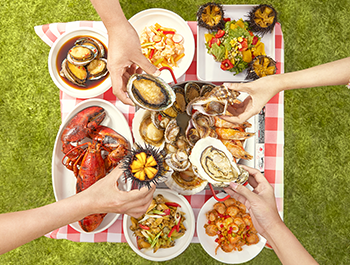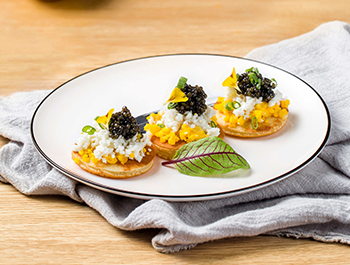ABOUT zoneco
獐子岛集团股份有限公司(ZONECO)始创于1958年,是农业产业化国家重点龙头企业、国家高新技术企业、国家级企业技术中心、国家级海洋牧场示范区、国家知识产权示范企业,全国首个“碳减排”标识企业。公司于2006年在深交所上市(股票代码002069)。2022年,獐子岛集团成为大连市国资控股企业。
品牌创立
黄金海域
全国门店
拥有员工
獐子岛海洋牧场是国家级海洋牧场示范区,作为公司主要海珍品资源基地,是集环境保护、资源养护、人工养殖和生态建设于一体的新型渔业生产模式。凭借北纬39°独有的地理区位与水质环境,使得该区域产出的刺参、扇贝、鲍鱼、海螺、海胆等成为海洋珍品。獐子岛刺参、獐子岛鲍鱼、獐子岛扇贝通过有机产品认证,并获得国家地理标志保护产品。
查看详情食品研发作为公司食材向食品企业转型的发动机和加速器,助力公司由传统渔业向现代渔业转型。公司运用企业自主创新和产学研合作平台,开展海产品深加工等关键技术创新与产业化示范。食品研发围绕战略资源、围绕自有工厂、围绕重点渠道、围绕核心客户,以市场为导向,开发上市的刺参、鲍鱼、扇贝、三文鱼、鳕鱼、鱿鱼、鲐鲅、虾等海洋预制菜产品涵盖即配、即烹、即热、即食四个系列近300个品种,精准服务消费者。
查看详情公司加快国内外市场建设,不断提升服务于消费者市场的能力。公司已建立了集原料采购、食品研发、生产加工、包装运输、批发零售、售后服务等全链条产供销体系。公司的销售模式根据销售产品特点的不同,建立了自营与经销结合的国内、国外多渠道、多层次的销售网络。
查看详情produced by zoneco
獐子岛源刺参产自北纬 39°国家级海洋牧场示范区,坚持“六个原”标准,即:原产地、原生态海域、原始基因、原始生长方式、原本形态和原初营养。獐子岛源刺参、鲍鱼、扇贝通过有机产品认证,并获得国家地理标志保护产品。獐子岛海参通过了国际检验机构SGS188项药残检测,并成为全球首个获得SGS CODEX VERIFIED Mark标志授权使用的海参产品。

北纬39°的獐子岛海洋牧场,拥有清洁海域,水质清澈、海洋资源丰富,盛产海参、鲍鱼、扇贝、海螺、海胆、珍蚝等海珍品,其产品与品质深受消费者喜爱。
獐子岛素有“鲍鱼之乡”美誉,盛产的皱纹盘鲍因其个大肉肥、鲜美营养名贯中外;海洋牧场出产的虾夷扇贝,积聚了大海的鲜香与肥美;海螺壳薄肉肥,素有“盘中明珠”的美誉;海胆来自冷水优质蛋白,颗粒饱满,肥美鲜甜;珍蚝属于三倍体单体牡蛎,因其个大、肉肥、口感好等优势深受广大消费者的青睐。

獐子岛休闲食品系列精选自獐子岛海洋牧场和大洋深海的优质原料,运用新含气调理技术,锁住海鲜的风味与营养。
为满足现代都市人快节奏的生活方式与健康饮食的追求,獐子岛集团倾力打造了一系列休闲食品,包括海味零食、佐餐罐头,以及休闲礼盒。每一款产品都是对健康、美味与便捷的匠心诠释,为您带来鲜美的味蕾体验。
獐子岛休闲食品系列,随时随地为您补充海洋优质蛋白,让每一刻的休憩时光都充满海洋的清新与活力。

随着现代生活步伐的日益加快,预制食品已成为众多消费者日常生活中的新宠。
獐子岛集团敏锐洞察市场需求,积极响应行业发展趋势,依托其得天独厚的海洋资源优势和坚实的市场基础,全力推进预制菜产业的创新升级。獐子岛集团研发上市独具特色的海参、鲍鱼、扇贝、三文鱼、虾等海洋系列食品受到消费者的青睐。
无论是职场拼搏的都市白领,还是追求高效生活的年轻一族,只需简单操作,就能化身料理达人,在家中轻松烹调海鲜大餐。

冻鲜食品作为一种融合了新鲜、便捷与全面营养的现代餐饮革新方案,精准定位于追求高效烹饪流程与健康膳食结构的消费者群体。精选优质海鲜食材,经过科学清洗、切割、标准化预处理,最大程度保留了食材的营养价值和鲜美口感,同时简化了烹饪过程。
冻鲜食品因其高度便捷性,受到广大消费者的喜爱,尤其是家庭主妇和城市白领。大大缩短了菜肴准备时间,提高了出餐效率。

鱼子酱,被誉为世界三大奢华美食之一。联合国粮农组织权威界定,真正的鱼子酱,仅限于鲟形目鱼类的珍贵鱼卵精心腌制而成,
时至今日,中国鱼子酱其卓越品质赢得全球赞誉。獐子岛集团旗下鱼子酱产业依托云南高山冷泉优质水源和独特气候条件,拥有多个高标准原生态冷泉鲟鱼养殖与鱼子酱生产加工基地。
鱼子酱是时光凝炼后的产物,长达十数年的漫长等待让鱼子酱变得更加珍贵。不同种类的鱼子酱各具风味,滋味万千。


营养滋补

冷水活鲜

休闲食品

预制食品

冻鲜食品

鱼子酱